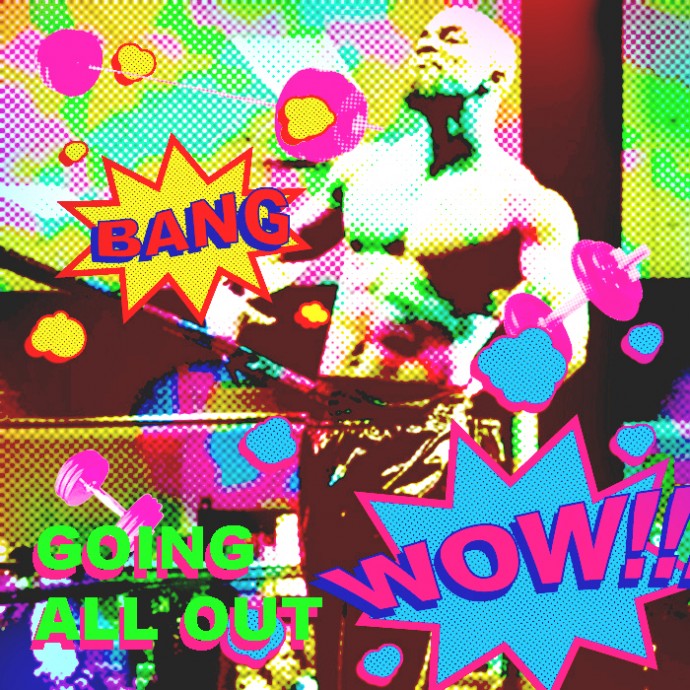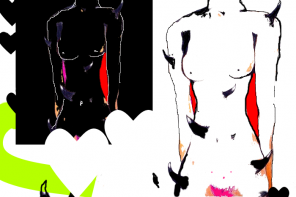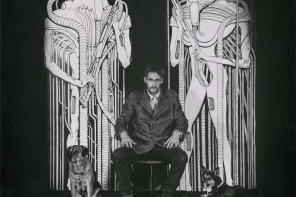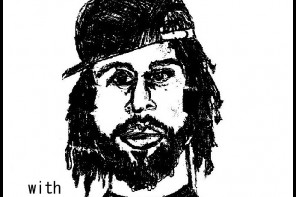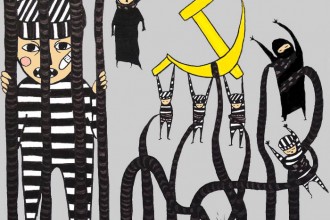At worst, professional wrestling is dismissed outright by those who see it as silly or childish. The timidness of the curious and uninitiated, on the other hand, may stand in the way of anything beyond a superficial understanding. Without a doubt, the intensity of the sport, as well as its passionate fanbase, can be more than a little intimidating. Cedric Spencer, thirty, is an independant professional wrestler based in Cincinnati, Ohio. The following are his reflections after having spent the last four and a half years dedicating himself to the profession. He explains why he embraced the opportunity, gives a behind-the-scenes look at its inner-world, and appeals to those of us who haven’t yet paid it the attention he feels it deserves.
I’ve always been a bit weird, and I never really fit in with the so-called ‘normal’ crowd. As I grew older and more physically fit, I started to become known as a bit of a showoff and someone who could be standoffish in the face of conflict. Regardless, I was still just a fun-loving guy at heart. So, when the opportunity to become a professional wrestler presented itself, I ran with it. What other job could have provided me a better chance to combine my natural charisma and athleticism, to be aggressive, and to have so much fun doing it? It really was a perfect fit, and my friends and family weren’t really surprised.
I was always a huge professional wrestling fan, but until I was put in touch with the right people at the right time, I hadn’t necessarily thought that it was something I could actually pursue. I had just gotten my Associate’s Degree in Criminal Justice when the field was struck by a hiring freeze. I was considering switching majors and getting another degree when a friend from high school got me a job as a videographer for an independent wrestling company. Before long, I was approached by the company’s main trainer with an offer to become a wrestler. Since then, I’ve dedicated myself to wrestling as my main career.
Having made this decision has meant spending forty-five or more hours a week on wrestling-related responsibilities, in addition to taking care of four children and working the night shift as a gas station attendant. I’m currently on the full-time roster of three different independent wrestling companies that operate mainly within the tri-state area, but I also occasionally get the chance to travel across the United States for special events and promotions. I have matches about three nights a week, train on another two or three, and go to the gym as often as possible. Sure, it’s a demanding schedule, but I figure that there’s no point in doing something unless I’m willing to go all out.
Professional wrestling is an extremely physical activity. Not only are you grappling with your opponent in the ring, but you’re also using the ropes for momentum and even striking, throwing, and landing on opponents with a varied arsenal of punches, kicks, and body slams. That being said, it also requires a surprising amount of mental focus. Things can get extremely technical when you consider that there are literally thousands of different moves, holds, counters, combinations, and submissions, and that they all require telegraphing and preparation. You can be physically skilled but still put on a really bad show if you’re not in synch with your opponent.
Not surprisingly, it’s also very dangerous work. Wrestlers wear little to no protection. Nothing protects your head, and there’s always the risk of landing incorrectly or painfully contorting your body. Torn muscles and ligaments are par for the course, and worse injuries are common. I’m personally lucky that one such incident early in my career didn’t end it forever.
During a match, my opponent rolled out of the ring and I gave chase. When I jumped from the ropes, I landed awkwardly on my ankle and broke it in three places. I thought that I’d never wrestle again, but after nine months of healing and rehabilitation, I was back at it. This time, however, I was a bit more cautious. It was a truly humbling experience. I’ve since learned to identify and respect my limitations. I had thought that I was indestructible because of the way I was built, but I realized that even the biggest dog in the yard can get bitten.
Throughout the entire process, I was supported by my wrestling colleagues. The inner world is like a brotherhood. We respect one another. Together we form one big, happy, dysfunctional family. This not only includes other wrestlers, but also our managers and valets. Even when we’re competing, we’re always looking out for one another. We consult before matches, and trust each other not to do anything the other person would find uncomfortable. We also have a rule to leave any real-world drama or animosity in the ring. This keeps us out of trouble and makes our performances that much better for our fans.
We don’t typically admit to, reference, or openly discuss with the public those elements of what we do that may be staged. Sure, some fans are totally aware of what’s going on, but we keep it as professional as possible. Whether we’re in the ring, at an event, or even in the building before or after a match, we stay in persona. If my character and another are currently on bad terms, we’ll act openly hostile towards one another. This keeps the storyline going and makes everything more real for the fans. The industry term to describe all this is ‘kayfabe’.
Every different wrestling federation has its own creative team. These teams create, tweak, and build up characters and the changing relationships between them. They decide who fights one another, who wins and loses, and how those characters respond in a way that guarantees a reaction from the fans and makes them eager to see what happens next. Over the years, storylines have gotten much deeper and more complex. Specifically, the addition of women wrestlers has made it possible to add things like romances and all their related complications. One thing, however, has remained constant. There have always been two central characters types.
‘Faces’ are the ‘good guys’. They’re the ones the fans love and pay money to see, and they have to have the looks to match their heroic personas. On the other hand, there are ‘bad guys’ called ‘heels’. These are the characters the fans love to hate. These guys look a bit more rugged and tend to use more underhanded tactics in the ring. However, in order to keep the audience on its feet, these roles can sometimes be reversed. A ‘heel’ might unexpectedly come to the the aid of a ‘face’ when all seems lost and, therefore, earn the crowd’s respect. Likewise, a pair of ‘faces’ might be pitted against a pair of ‘heels’ when, suddenly, one of them abandons or even turns on the other. Either way, the fans’ surprise and newfound admiration or hatred of certain characters makes them that much more invested in the storyline.
My character, Blackhawk, is a part of a group called the Sons of Misery. He tends to be a ‘heel’. When creating him, I wanted to be able to play a role that allowed me to vent my real-life frustrations. You could say that Blackhawk represents the parts of myself that aren’t necessarily socially acceptable. He is a bit of a hired hitman. He’s mean, cocky, ruthless, and does things that benefit himself and those whose allegiances best serve his immediate interests, with little regard for anyone who gets in his way. When I make my entrance, I taunt the audience and show off my physique. This is a surefire way to get a rise out of them.
It is the fans, after all, who are my main source of motivation and inspiration. It’s their love for and dedication to professional wrestling that gave me this opportunity in the first place, and it’s their continued support that keeps me going. Of course, my children also love what I do and emphatically encouraged me to stick with it. I do hesitate to allow my youngest three to watch me wrestle for fear that they might get confused. I’m trying to instill in them the value that violence isn’t always the only way to solve a problem. If my youngest son saw me in the ring kicking someone in the face, not only would I look like a hypocrite, but he also might emulate me and end up hurting one of his friends.
My goal is probably the same as every other independent professional wrestler. I want to get all the way to the top and be signed by a major company. I want to wrestle in an arena packed with forty-thousand people and hear them chanting my name. At my current rate, I’d say my chances are actually pretty good. I’m young, I’ve done a good job of maintaining my physique, and I’ve even been told by a talent scout that I definitely have the look. That being said, making it in professional wrestling is extremely competitive. Unlike other sports, you can’t expect to get noticed based on skill, alone. You’ve also got to have charisma and the right body type.
Steroids are obviously the quickest way to achieve the desired, professional look. Not surprisingly, the use of performance enhancing drugs within wrestling is probably on par with most other sports. The difference, in my opinion, is that I don’t think steroids have necessarily had a detrimental impact on professional wrestling, itself. That being said, there have been high-profile cases where top-tier wrestlers have died due to drug-related complications. Thankfully, I’ve always been terrified of needles. This alone, to be honest, has been enough to discourage me. Besides, I’ve been fortunate enough to have been pretty naturally fit.
When it’s all said and done, professional wrestling may not be everyone’s cup of tea. Many people probably think of it as juvenile. A child is definitely more willing to suspend his or her belief. This is, no doubt, at the root of such criticism. But then again, is watching a film really any different? You may know who the actor is in real life and that what you’re watching isn’t real, but does this ruin your ability to enjoy yourself and be entertained?
I’d recommend that anyone who hasn’t yet given professional wrestling a chance to do so. You’ll probably be surprised. Not only is it year-round, but it’s always changing. You’re not stuck with the same teams and predictable or arbitrary rivalries being played out year after year. In a way, it’s like a soap opera for men. Characters evolve, along with the relationships between them. There is always a reason that’s integral to the storyline for anyone to face off in the ring. Go to a match, bring the whole family, and know that you’ll be having a totally unique experience. While you’re there, feel free to yell at the wrestlers. Not only is this allowed, but it’s encouraged. Besides, we’ll probably yell right back at you. This is our way of saying “thanks”.

